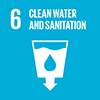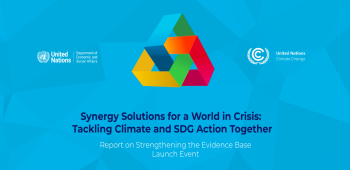
Water and Sanitation
Targets and Indicators

6.1
By 2030, achieve universal and equitable access to safe and affordable drinking water for all
6.1.1
Proportion of population using safely managed drinking water services

6.2
By 2030, achieve access to adequate and equitable sanitation and hygiene for all and end open defecation, paying special attention to the needs of women and girls and those in vulnerable situations
6.2.1
Proportion of population using (a) safely managed sanitation services and (b) a hand-washing facility with soap and water

6.3
By 2030, improve water quality by reducing pollution, eliminating dumping and minimizing release of hazardous chemicals and materials, halving the proportion of untreated wastewater and substantially increasing recycling and safe reuse globally
6.3.1
Proportion of domestic and industrial wastewater flows safely treated
6.3.2
Proportion of bodies of water with good ambient water quality

6.4
By 2030, substantially increase water-use efficiency across all sectors and ensure sustainable withdrawals and supply of freshwater to address water scarcity and substantially reduce the number of people suffering from water scarcity
6.4.1
Change in water-use efficiency over time
6.4.2
Level of water stress: freshwater withdrawal as a proportion of available freshwater resources

6.5
By 2030, implement integrated water resources management at all levels, including through transboundary cooperation as appropriate
6.5.1
Degree of integrated water resources management
6.5.2
Proportion of transboundary basin area with an operational arrangement for water cooperation

6.6
By 2020, protect and restore water-related ecosystems, including mountains, forests, wetlands, rivers, aquifers and lakes
6.6.1
Change in the extent of water-related ecosystems over time

6.a
By 2030, expand international cooperation and capacity-building support to developing countries in water- and sanitation-related activities and programmes, including water harvesting, desalination, water efficiency, wastewater treatment, recycling and reuse technologies
6.a.1
Amount of water- and sanitation-related official development assistance that is part of a government-coordinated spending plan

6.b
Support and strengthen the participation of local communities in improving water and sanitation management
6.b.1
Proportion of local administrative units with established and operational policies and procedures for participation of local communities in water and sanitation management
Progress and Info
None of the SDG 6 targets are on track to be met. As of 2022, 2.2 billion people were without access to safely managed drinking water and 3.5 billion lacked access to safely managed sanitation. Between 2002 and 2021 droughts affected more than 1.4 billion people. As of 2022, roughly half of the world’s population experienced severe water scarcity for at least part of the year, while one quarter faced ‘extremely high’ levels of water stress. Climate change worsens these issues, posing significant risks to social stability. While transboundary river and lake basins are home to approximately 40% of the world’s population and are shared by 153 countries, less than a fifth of these countries have operational arrangements for cooperation in place for all their transboundary waters. Coordinated global action on integrated water management, addressing the impacts of climate change on water resources, and better management of shared waters are key to restoring focus on the Goal.
Targets 6.1 and 6.2: Between 2015 and 2022, the population using safely managed drinking water increased from 69% to 73%, the population using safely managed sanitation increased from 49% to 57% and the population using basic hygiene services increased from 67% to 75%. Achieving universal coverage of safely managed drinking water, safely managed sanitation, and basic hygiene services by 2030 will require respective increases of 6x, 5x, and 3x in the current global rates of progress.
Target 6.3: Among the 73 countries reporting on both total wastewater generation and total wastewater treatment in 2022, 76% of total wastewater flows received at least some treatment. Of the 42 countries that specified the level of treatment, 60% of total wastewater flows were safely treated (i.e. at least secondary treatment). In all world regions, many rivers, lakes and aquifers are still in good condition – as of 2023, 56% of water bodies assessed in 120 countries have good water quality. However, countries that implement the most extensive monitoring programmes show that water quality is degrading since 2017.
Target 6.4: Water use efficiency rose from $17.4/m3 in 2015 to $20.8/m3 in 2021, a 19% increase. At the global level, the water stress level reached an average level of 18.6% in 2021 but it hides large regional variations as some regions in the world show critical water stress levels which may compromise their economic and social development. Globally, water stress level has slightly increased by 3% from 2015 to 2021.
Target 6.5: Global progress on implementing integrated water resources management remains slow – 49% in 2017, 54% in 2020, 57% in 2023, not on track to reach the 2030 target (91%). Only 43 out of 153 countries have operational arrangements in place for 90% or more of their shared transboundary waters (rivers, lakes and aquifers), and more than 20 countries have no operational arrangements in place for any of their transboundary waters. Since 2020 only around ten new arrangements for transboundary water cooperation have been adopted.
Target 6.6: The world has experienced a net increase in permanent surface water between 2005 and 2022, much of which resulted from climate change and reservoir filling. While this global net gain is positive, it is important to recognize that the data also include losses of permanent water in some regions linked to droughts and increased water demands.
Target 6.a: ODA disbursements to the water sector increased between 2021 and 2022 by 10% to $8.5 billion, reversing a declining trend seen over the past five years.




